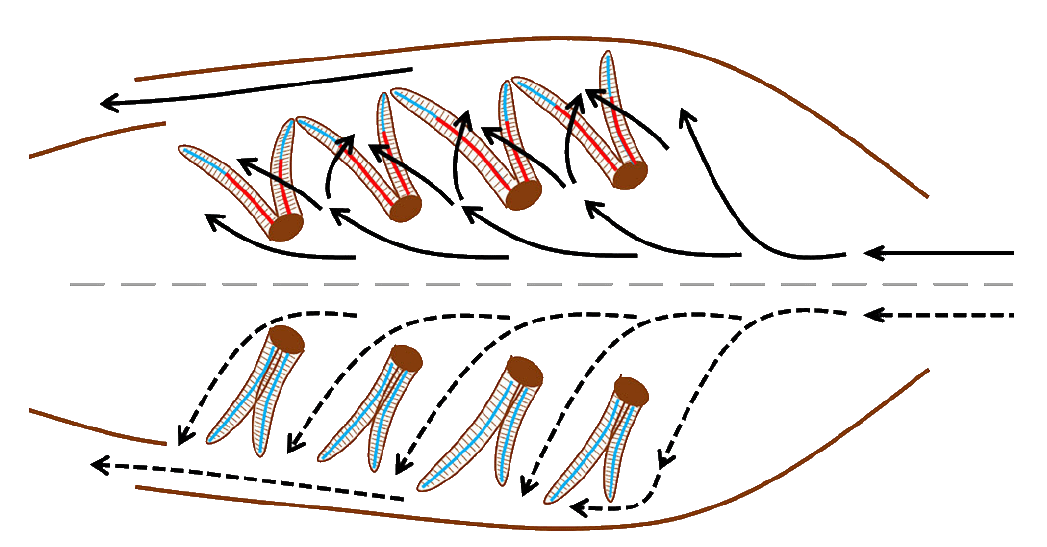The behaviour-physiology nexus
The phenotype of animals is shaped by their surrounding environment (phenotypic plasticity), but animals can also choose which environments they experience. I am interested in how these processes interact, and what this means for animals that must cope with environmental change. A particular interest is understanding how mangrove fishes use both behavioural and physiological strategies to survive extremely harsh aquatic conditions (e.g. low oxygen, high carbon dioxide and hydrogen sulfide). Many of these fishes are amphibious, and behavioural escape from water to terrestrial environments is a key last line of defence. I have found that moving onto land causes plastic morphological and physiological changes that in turn affect future habitat choice decisions, and am currently exploring what this means for local adaptation (collaboration with Patricia Wright, Giulia Rossi, Emily Standen, Ryan Earley). Another major focus is understanding why fishes sometimes choose habitats that maximize their physiological performance, but often don't (with Graham Scott and Sigal Balshine).


Select publications:
Turko and Rossi (2022). Habitat choice promotes and constrains phenotypic plasticity. Biology Letters 18: 20210468.
Rossi, Tunnah, Martin, Turko, Taylor, Currie, and Wright (2019). Mangrove fishes rely on emersion behavior and physiological tolerance to persist in sulphidic environments. Physiological and Biochemical Zoology 92: 316-325.
Turko et al. (2018) Emersion behaviour underlies variation in aquatic respiratory function in the amphibious fish Kryptolebias marmoratus. Journal of Experimental Biology 221: jeb.168039.
Livingston, Bhargav, Turko, Wilson, Wright (2018) Widespread use of emersion and cutaneous ammonia excretion in Aplocheiloid killifishes. Proceedings of the Royal Society B 285: 20181496.
Turko et al. (2011) Behaviour drives morphology: voluntary emersion patterns shape gill structure in genetically identical mangrove rivulus. Animal Behaviour 82:39-47.
Conservation biology of fishes
Why are some fishes endangered, while others are ubiquitous and even invasive? I am interested in understanding the physiological basis of these inter-specific differences, and I work with government and non-profit conservation practitioners to use these data to help endangered species recovery. I have studied the toxic effects of copper on mangrove rivulus and blue land crabs (collaboration with Tamzin Blewett), and am currently studying the behavioural and physiological consequences of anthropogenic habitat modification for endangered redside dace with a long-term goal of reintroduction in suitable habitats (with Trevor Pitcher).


Select publications:
Thorstensen, Turko, Heath, Jeffries, and Pitcher (2022) Acute thermal stress elicits interactions between gene expression and alternative splicing in a fish of conservation concern. J Exp Biol 225: jeb244162.
Turko et al (2021) Choosing source populations for conservation reintroductions: lessons from variation in thermal tolerance among populations of the imperilled redside dace. Can J Fish Aquat Sci 78: 1347-1355
Turko et al (2020) Thermal tolerance depends on age, season, and body condition in imperiled redside dace Clinostomus elongatus. Conserv Physiol 8: 10.1093/conphys/coaa062.
Blewett, Simon, Turko, and Wright (2017) Copper alters hypoxia sensitivity and the behavioural emersion response in the amphibious fish Kryptolebias marmoratus. Aquatic Toxicology 189: 25-30.
Respiratory physiology and plasticity
The structure and function of fish gills depends on many factors, including intrinsic metabolic demands and external environmental challenges. I am broadly interested in how these trade-offs shape fish gills both within the lifetimes of individuals (phenotypic plasticity) and over evolutionary time, and what this means for respiratory performance in different environments. A particular focus has been on understanding how the amphibious fishes prevent their gills collapsing while they subject to gravity on land - I have found that tissue remodelling occurs on several levels of organization (bone, cartilage, lamellae) to provide structural support. I am also actively investigating how the architecture and material properties of gills contribute to respiratory efficiency, hypoxia tolerance, and resistance to damage from suspended sediment.



Select publications:
Turko et al. (2020) Calcified gill filaments increase respiratory function in fishes. Proceedings B 287: 20192796.
Turko et al. (2019) Gill remodelling during terrestrial acclimation in the amphibious fish Polypterus senegalus. Journal of Morphology 280: 329-338.
Turko et al. (2018) Emersion behaviour underlies variation in aquatic respiratory function in the amphibious fish Kryptolebias marmoratus. Journal of Experimental Biology 221: jeb.168039.
Turko et al. (2017) Skeletal stiffening in an amphibious fish out of water is a response to increased body weight. Journal of Experimental Biology 220, 3621-3631.